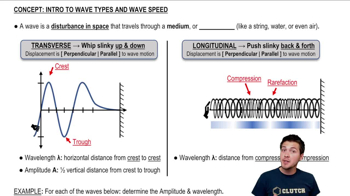18. Waves & Sound
Intro to Waves
18. Waves & Sound
Intro to Waves
Additional 3 creators.
Learn with other creators
Practice this topic
- Multiple Choice
A satellite captures images of a tsunami, and properties of the tsunami can be found from these images, providing important information to people who need to evacuate coastal areas. If satellite images of a tsunami show the distance from one peak to another is 500 km, and the period is 1 hour, how much time do people have to evacuate if the tsunami is found to be 100 km off shore?
- Multiple ChoiceA string with a linear mass density of is under of tension. How long would it take a wave pulse on this string to travel
- Multiple Choice
A wave has a wavelength of 10mm and moves at a speed of 50mm/s. What is the frequency of this wave?
- Open QuestionA horizontal string tied at both ends is vibrating in its fundamental mode. The traveling waves have speed v, frequency f, amplitude A, and wavelength λ. (a) Calculate the maximum transverse velocity and maximum transverse acceleration of points located at (i) x = λ/2, (ii) x = λ/4, and (iii) x = λ/8, from the left-hand end of the string.
- Open QuestionOne string of a certain musical instrument is 75.0 cm long and has a mass of 8.75 g. It is being played in a room where the speed of sound is 344 m/s. (a) To what tension must you adjust the string so that, when vibrating in its second overtone, it produces sound of wavelength 0.765 m? (Assume that the break-ing stress of the wire is very large and isn't exceeded.) (b) What frequency sound does this string produce in its fundamental mode of vibration?
- Open QuestionA horizontal string tied at both ends is vibrating in its fundamental mode. The traveling waves have speed v, frequency f, amplitude A, and wavelength λ. (c) How much time does it take the string to go from its largest upward displacement to its largest downward displacement at the points located at (i) x = λ/2, (ii) x = λ/4, and (iii) x = λ/8, from the left-hand end of the string.
- Open QuestionA horizontal string tied at both ends is vibrating in its fundamental mode. The traveling waves have speed v, frequency f, amplitude A, and wavelength λ. (b) What is the amplitude of the motion at the points located at (i) x = λ/2, (ii) x = λ/4, and (iii) x = λ/8, from the left-hand end of the string?








